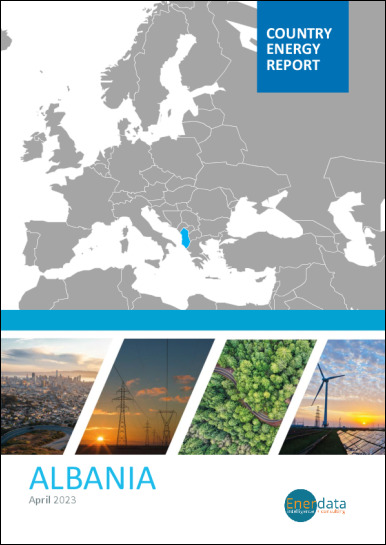- Update
-
- Format
- 3 files (PDF report, 2 Excel files)
- Pages
-
33 (Report only)
- Delivery
- Immediate by e-mail
- GENERAL OVERVIEW
- INSTITUTIONS AND ENERGY POLICY
- ENERGY COMPANIES
- ENERGY SUPPLY
- ENERGY PRICES
- ENERGY CONSUMPTION
- ISSUES AND PROSPECTS
- DATA TABLES
- ABBREVIATIONS
- GLOSSARY
Buy Albania energy report
Price without VAT. Depending on your statute and location, VAT might be applicable. Get in touch with us for more information.
After validation, you will immediately receive 3 files by email (one pdf report and 2 excel files containing the datasets).
Overview
This analysis includes a comprehensive Albania energy market report and updated datasets. It is derived from the most recent key economic indicators, supply and demand factors, oil and gas pricing trends and major energy issues and developments surrounding the energy industry. The report provides a complete picture of the country situation, dynamics, current issues and future prospects. With market data and continuous follow-up of markets news, this report brings clear and concise insights with which to tackle national energy challenges and opportunities. Browse the tabs below for a detailed table of contents, the list of graphs and tables, and details on the data files.
Highlights
- Albania is slowly transposing the European acquis.
- National power utility KESh accounts for over half of power generation.
- Bankers Petroleum accounts for over 90% of oil and gas production.
- The power supply is highly dependent on hydropower, which fluctuates a lot.
- Oil production is limited and decreasing.
- Electricity prices are much lower than in the EU, while gasoline and diesel prices are closer to EU prices.
- Energy consumption has been declining since 2017.
- Oil and hydropower dominate the energy mix.
- The country continues to develop its hydropower potential and is also accelerating on solar and wind projects.
- The country will benefit from the TAP gas pipeline.
Institutions & Energy Policy
The Ministry of Infrastructures and Energy supervises the energy sector.
The NationalAgency of Natural Resources (AKBN) is in charge of implementing the energy policy and manages the interests of the Albanian state in activities related to hydrocarbons, mining, and energy.
Energy Companies
Electricity:
KESh, Albanian Power Corporation is the main generator with a capacity of 1 355 MW in 2023 (half of the total capacity), mainly made up of hydropower, spread over 3 power plants (not including the 98 MW Vlore thermal power plant, which has been idle since 2012 pending its possible switch from oil to gas).
Energy Supply
Oil:
Oil production has halved since 2014, from 1.4 Mt to 0.6 Mt in 2023, due to low investment in the sector. Most of this production is exported. Production tripled between 2004 and 2014.
Energy Prices
Oil:
Gasoline and diesel prices are liberalised and tend to follow global trends. They were quite similar until 2020, but diesel is now cheaper than gasoline. In 2022, prices surged to a record high (+27% for gasoline and +38% for diesel, in €), prompting the government to set up a national transparency board to regulate fuel prices from March 2022 to June 2023.
Energy Consumption
Consumption per capita is much lower than the EU average, at approximately 0.8 toe (72% below the EU average), including 2 500 kWh of electricity (53% below the EU average) (2023).
Issues & Prospects
Oil:
Infrastructure projects, such as the construction of the AMBO (Albanian Macedonian Bulgarian Oil) pipeline, have made little progress. Plans to modernise the two refineries to restore production to the original design capacity and meet current EU regulations for fuels have been frozen.
- GRAPH 1: CO2-energy emissions (MtCO2)
- GRAPH 2: Installed electric capacity by source (2023, %)
- GRAPH 3: Gross power production by source (TWh)
- GRAPH 4: Power generation by source (2023, %)
- GRAPH 5: Gasoline & diesel prices (€/l)
- GRAPH 6: Electricity prices for households (€c/kWh)
- GRAPH 7: Consumption trends by energy source (Mtoe)
- GRAPH 8: Total consumption market share by energy (2023, %)
- GRAPH 9: Final consumption market share by sector (2023, %)
- Economic Indicators: Annual historical data including population, GDP growth, imports and exports, inflation rate, energy security and efficiency indicators, CO2 emissions.
- Supply Indicators: Historical data including oil and gas reserves, electric and refining capacity, energy production, power production and external trade. All are detailed by energy source.
- Demand Indicators: Historical data including consumption per inhabitant, consumption trends, total consumption by energy source, final consumption by energy source and sector, and electricity consumption by sector.
- Energy Balances: Single table displaying the overall energy industry balance per annum, also graphically displayed by energy sub-segment.
- Infrastructure Projects: Covers power plant projects by energy, technology, status and operator.
The Albania energy market data since 1990 and up to
is included in the Excel file accompanying the Albania country report.
It showcases the historical evolution, allowing users to easily work with the data.
Key Data included in the excelsheet:
- Economic indicators: Annual historical economic indicators, energy security, energy efficiency and CO2 emissions.
- Supply indicators: Annual historical reserves, capacity, production and external trade (imports(+) exports(-) balance).
- Demand indicators: Annual historical consumption per capita, consumption trends, total consumption, final consumption (per energy and per sector) and electricity consumption total and per sector.
- Energy Balance: total and per energy.
- Albania Energy Prices: In addition to the analysis provided on the report we also provided a data set which includes historical details on the Albania energy prices for the follow items: price of premium gasoline (taxes incl.), price of diesel (taxes incl.), price of electricity in industry (taxes incl.), price of electricity for households (taxes incl.), price of natural gas in industry (taxes incl.), prices of natural gas for households (taxes incl.), spot price of Brent and CO2 emissions (from fuel combustion).
 Energy and Climate Databases
Energy and Climate Databases Market Analysis
Market Analysis